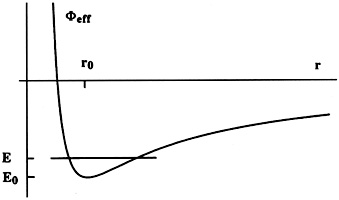

| © CAMBRIDGE UNIVERSITY PRESS 2000 |
13.1. Action and angle variables
For the dynamics of disk galaxies the basic situation to be
considered is that of a mean field potential
 that is stationary and
axisymmetric around the z-axis. Note that such potential is very
different
from the Keplerian potential generated by a point mass located at
r = 0. In the
equatorial plane defined by z = 0, the calculation of orbits is
reduced to a one-dimensional problem by introducing an effective potential
that is stationary and
axisymmetric around the z-axis. Note that such potential is very
different
from the Keplerian potential generated by a point mass located at
r = 0. In the
equatorial plane defined by z = 0, the calculation of orbits is
reduced to a one-dimensional problem by introducing an effective potential
 |
(13.8) |
so that the energy integral can be written as
 |
(13.9) |
 |
Figure 13.2. Sketch of the effective potential for equatorial orbits in an axisymmetric field. |
Thus the radial momentum (in our case this is identified with the
radial velocity) can be expressed as a function of r and of the
integrals of
the motion E and J, with J the specific angular
momentum. For a large class of potentials, the function
 eff exhibits
one minimum at r = r0 (see
Fig. 13.2), which
identifies the radius of circular orbits
with angular momentum J. If we take J > 0, and define
eff exhibits
one minimum at r = r0 (see
Fig. 13.2), which
identifies the radius of circular orbits
with angular momentum J. If we take J > 0, and define
 |
(13.10) |
the guiding center radius is related to the specific angular momentum by
 |
(13.11) |
which is generally one-to-one; in order for
 eff to
exhibit a minimum at r0, the function
J = J(r0) defined by Eq. (11) must be
monotonically increasing.
Typically, for a given value of J bound orbits are associated with
energies in the range E0 < E < 0, with
eff to
exhibit a minimum at r0, the function
J = J(r0) defined by Eq. (11) must be
monotonically increasing.
Typically, for a given value of J bound orbits are associated with
energies in the range E0 < E < 0, with
 |
(13.12) |
the minimum energy which corresponds to the circular orbit. In the radial coordinate the motion is periodic and takes place between two turning points rin(E, J) < r0 < rout(E, J). A radial action variable can thus be set
 |
(13.13) |
with the property
 |
(13.14) |
Here the radial frequency is defined as
 r =
2
r =
2 /
/
 r,
with the bounce time given by
r,
with the bounce time given by
 |
(13.15) |
In turn, the angular frequency is defined by
 |
(13.16) |
Orbits are closed (in the inertial frame of reference) if the ratio between the two frequencies is rational.